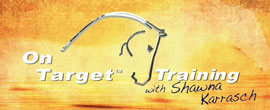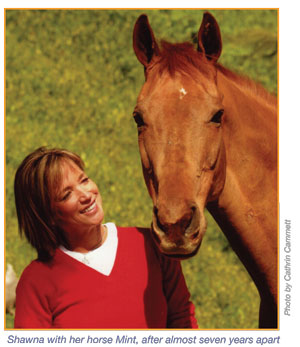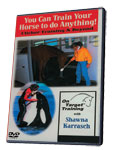By Jackie McFarland
Click This! The Who, What, Where and Whys of Positive Reinforcement Training

Some call it Clicker Training, some call it Target Training, some don’t like to recognize it at all. But meet Shawna Karrasch, the energetic, effervescent person behind On Target Training and change your perspective.
WHO is Shawna Karrasch?
I didn’t grow up as a horse girl. We did have horses on my grandfather’s farm. They were quarter horses and super broke and safe, safe, safe. We would have to drive to find them – it was 300 acres and so we had to go search them out.
I felt like they tolerated us and I didn’t connect with them because back then I felt like we were a burden to the horses. I decided I only wanted to be with animals where I could add to their life in some way; I didn’t want impose myself on any animal.
I actually trusted animals more than humans when I was a little girl. They were always honest and love was unconditional. It’s where I learned to trust and nurture and I really wanted it to be a two-way street.
We moved out to San Diego when I was 13 and I was pretty much a surf and ski gal. When I was going to college I took a Field Study Class on Finback Whales and biology classes and so I came home wanting to get a job at Sea World. The second summer I worked in the Animal Training Dept. and after the season they offered me a full-time position. And that’s where I stayed for the next 10 years. Through the method of Positive Reinforcement Training I worked with killer whales, dolphins, sea lions, walruses, and otters to train them to do husbandry as well as show behaviors. I also did the performances with them. It was a lot of hard work, required a lot of patience, but I did love it.
 My next exposure to horses was in 1992 when Elizabeth Busch Burke gave us tickets to a Grand Prix in Del Mar. A bunch of trainers went, but I was the only one that was so taken by it. I was really intrigued. Hap Hansen caught my eye; he made it look so smooth and effortless. As I got involved I realized that the training methods used were clearly successful but didn’t use positive reinforcement methods at all. I started taking lessons, bought a horse and everything that went with it [laughs]. Interestingly, when I met Vinton Karrasch he wanted to learn more about how we trained marine mammals and I wanted to learn more about training horses.
My next exposure to horses was in 1992 when Elizabeth Busch Burke gave us tickets to a Grand Prix in Del Mar. A bunch of trainers went, but I was the only one that was so taken by it. I was really intrigued. Hap Hansen caught my eye; he made it look so smooth and effortless. As I got involved I realized that the training methods used were clearly successful but didn’t use positive reinforcement methods at all. I started taking lessons, bought a horse and everything that went with it [laughs]. Interestingly, when I met Vinton Karrasch he wanted to learn more about how we trained marine mammals and I wanted to learn more about training horses.
So together we started this incredible adventure of mixing our knowledge – his of horses and mine of positive reinforcement training – and developed On Target Training, which at the time was virtually unheard of in the horse world.
WHY Positive Reinforcement Training (PRT, technically R+)?
First of all these are proven principles. It’s not a lark or even theory. Or someone’s special language or method they came up with and named. It is quite a successful system – there are several books, at Sea World we used “Behavior Principles” (Charles Ferster & Stuart Culbertson) and “A Primer to Operant Conditioning” (G. S. Reynolds). Why we used PRT at Sea World is it minimizes frustration, which can lead to aggression. With horses that’s bucking, rearing, kicking, biting or any resistance behavior. We have to remember that it isn’t our concept of what is valuable – like a pat on the neck which is nice and all but the horse has survival instincts and food is much more of a valuable reward for them.
For example, I have never seen a horse free jump – completely loose in a ring with no chute – a 3’6″ fence via a pat on the neck. But I’ve seen them do it repeatedly when the reward is of value – food.
When it becomes meaningful for the horse – it intrinsically changes the value of the relationship. It’s Pavlovian in a way. Through the repeated positive reinforcement – be it husbandry, under saddle, fear of mounting, any aspect of the horse’s daily life – you see such a difference in the horse. You actually start to see them learn how to think and because we draw attention to what is good, we change their motivation to want to do what is asked in order to receive the reward. And liking it.
A good illustration of this is a study they did when they gave animals (a variety of species) free food to eat as they wanted. And then they took that away and taught those same animals to hit a lever to earn the food. And when the scientists gave the animals both options – more often than not the animals chose to hit the lever over just going for the free food.
We tend to focus on the physical aspects – which is of course are important – but we tend to forget their psychological needs. That needs stimulating too and if we do so in a positive way we get positive results.
WHERE to use PRT?
Anywhere – it truly covers every issue. For the most minor of issues – from picking up a foot to standing still to rearing to trailer loading to jumping water. You can teach a horse to have heart with this type of training. Also anyplace – I work with horses in stalls, cross ties, paddocks, pastures, arenas – wherever they need to be.
With every behavior I work on my primary focus is always attitude. If they have a good attitude you can teach a horse anything – so a positive attitude is essential to success. It’s about trusting them and them also trusting you.
WHEN to use PRT?
John and Beezie Madden recognized the value of this training more than fifteen years ago. We hadn’t even ‘unpacked the box’ of how the method worked yet. But John had vision; he could see what was inside the box before we even opened it. He embraced the system and said please come to our farm and lets start this business. During the year we worked together, Vinton and I lived there in 1995-1996, I learned so much from John and Beezie and they from me – they taught me traditional training methods that I use all the time. And as I understand they are still utilizing the On Target Training we developed all those years ago.
 That is where and when we literally wrote the book and produced the DVD, “You Can Train Your Horse To Do Anything – Clicker Training and Beyond”. And of course we taught Judgment to get over the one issue that was keeping him from becoming a top horse – jumping water. They went to Spruce Meadows and Beezie took him in the International Ring, went by the water (which he wouldn’t have done so willingly before), clicked and then started her course. Once she finished, and he jumped the water, she reinforced. It was awesome!
That is where and when we literally wrote the book and produced the DVD, “You Can Train Your Horse To Do Anything – Clicker Training and Beyond”. And of course we taught Judgment to get over the one issue that was keeping him from becoming a top horse – jumping water. They went to Spruce Meadows and Beezie took him in the International Ring, went by the water (which he wouldn’t have done so willingly before), clicked and then started her course. Once she finished, and he jumped the water, she reinforced. It was awesome!
HOW MUCH PRT?
This system can be used alone but more importantly it can augment any training method. There are plenty of successful trainers who certainly don’t need to change the way they work. But doesn’t every horse have some issue no matter how minor or major? The horse may perform beautifully but not trailer well. Or possibly a spooking issue is keeping a horse from advancing. Any issue can be approached and overcome through Positive Reinforcement Training. And it usually doesn’t take an inordinate amount of time once they learn the basics of the method.
There are so many questions that can be answered and horses that can change through this type of work. And although I have a clear understanding of what it takes to train a top-level horse, I don’t claim to be a trainer. I am an expert in Positive Reinforcement Training and feel confident that we were not only the first to successfully use the system with horses but to date there isn’t an issue that can’t be solved through utilizing this system correctly.
So how much? As much as you are willing to see a positive change!
Thank you, Shawna – it’s both interesting and inspiring. See more at ShawnaKarrasch.com or facebook.com/horsetraining.



